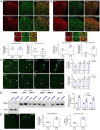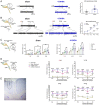Pain hypersensitivity in a pharmacological mouse model of attention-deficit/hyperactivity disorder
- PMID: 35858441
- PMCID: PMC9335339
- DOI: 10.1073/pnas.2114094119
Pain hypersensitivity in a pharmacological mouse model of attention-deficit/hyperactivity disorder
Abstract
Clinical evidence suggests that pain hypersensitivity develops in patients with attention-deficit/hyperactivity disorder (ADHD). However, the mechanisms and neural circuits involved in these interactions remain unknown because of the paucity of studies in animal models. We previously validated a mouse model of ADHD obtained by neonatal 6-hydroxydopamine (6-OHDA) injection. Here, we have demonstrated that 6-OHDA mice exhibit a marked sensitization to thermal and mechanical stimuli, suggesting that phenotypes associated with ADHD include increased nociception. Moreover, sensitization to pathological inflammatory stimulus is amplified in 6-OHDA mice as compared to shams. In this ADHD model, spinal dorsal horn neuron hyperexcitability was observed. Furthermore, ADHD-related hyperactivity and anxiety, but not inattention and impulsivity, are worsened in persistent inflammatory conditions. By combining in vivo electrophysiology, optogenetics, and behavioral analyses, we demonstrated that anterior cingulate cortex (ACC) hyperactivity alters the ACC-posterior insula circuit and triggers changes in spinal networks that underlie nociceptive sensitization. Altogether, our results point to shared mechanisms underlying the comorbidity between ADHD and nociceptive sensitization. This interaction reinforces nociceptive sensitization and hyperactivity, suggesting that overlapping ACC circuits may be targeted to develop better treatments.
Keywords: anterior cingulate cortex; attention-deficit/hyperactivity disorder; comorbidity; pain sensitization; spinal cord.
Conflict of interest statement
The authors declare no competing interest.
Figures





Similar articles
-
Hyperactivity and impulsivity in adult attention-deficit/hyperactivity disorder is related to glutamatergic dysfunction in the anterior cingulate cortex.World J Biol Psychiatry. 2018 Oct;19(7):538-546. doi: 10.1080/15622975.2016.1262060. Epub 2016 Dec 15. World J Biol Psychiatry. 2018. PMID: 27973969
-
P2X4 signalling contributes to hyperactivity but not pain sensitization comorbidity in a mouse model of attention deficit/hyperactivity disorder.Front Pharmacol. 2024 Jan 4;14:1288994. doi: 10.3389/fphar.2023.1288994. eCollection 2023. Front Pharmacol. 2024. PMID: 38239187 Free PMC article.
-
Neonatal 6-OHDA lesion model in mouse induces Attention-Deficit/ Hyperactivity Disorder (ADHD)-like behaviour.Sci Rep. 2018 Oct 18;8(1):15349. doi: 10.1038/s41598-018-33778-0. Sci Rep. 2018. PMID: 30337626 Free PMC article.
-
[Structural and functional neuroanatomy of attention-deficit hyperactivity disorder (ADHD)].Encephale. 2009 Apr;35(2):107-14. doi: 10.1016/j.encep.2008.01.005. Epub 2008 Jul 7. Encephale. 2009. PMID: 19393378 Review. French.
-
Cingulate impairments in ADHD: Comorbidities, connections, and treatment.Handb Clin Neurol. 2019;166:297-314. doi: 10.1016/B978-0-444-64196-0.00016-9. Handb Clin Neurol. 2019. PMID: 31731917 Review.
Cited by
-
Multiple Posterior Insula Projections to the Brainstem Descending Pain Modulatory System.Int J Mol Sci. 2024 Aug 24;25(17):9185. doi: 10.3390/ijms25179185. Int J Mol Sci. 2024. PMID: 39273133 Free PMC article.
-
Overactive PKA signaling underlies the hyperalgesia in an ADHD mouse model.iScience. 2024 Oct 5;27(11):111110. doi: 10.1016/j.isci.2024.111110. eCollection 2024 Nov 15. iScience. 2024. PMID: 39507260 Free PMC article.
-
Targeting Neuroinflammation with Abscisic Acid Reduces Pain Sensitivity in Females and Hyperactivity in Males of an ADHD Mice Model.Cells. 2023 Jan 31;12(3):465. doi: 10.3390/cells12030465. Cells. 2023. PMID: 36766806 Free PMC article.
-
Innovative therapeutic strategies using ADHD medications tailored to the behavioral characteristics of patients with chronic pain.Front Pharmacol. 2025 Feb 26;16:1500313. doi: 10.3389/fphar.2025.1500313. eCollection 2025. Front Pharmacol. 2025. PMID: 40078279 Free PMC article. Review.
-
Correlation between attention deficit/hyperactivity disorder and chronic pain: a survey of adults in Japan.Sci Rep. 2025 Apr 16;15(1):13165. doi: 10.1038/s41598-025-95864-4. Sci Rep. 2025. PMID: 40240787 Free PMC article.
References
-
- Biederman J., Attention-deficit/hyperactivity disorder: A selective overview. Biol. Psychiatry 57, 1215–1220 (2005). - PubMed
-
- American Psychiatric Association, Diagnostic and Statistical Manual of Mental Disorders (American Psychiatric Association, Washington, DC, ed. 5, 2013).
-
- Kooij J. J., et al. , Distinguishing comorbidity and successful management of adult ADHD. J. Atten. Disord. 16, 3S–19S (2012). - PubMed
-
- Schatz D. B., Rostain A. L., ADHD with comorbid anxiety: A review of the current literature. J. Atten. Disord. 10, 141–149 (2006). - PubMed
Publication types
MeSH terms
Substances
LinkOut - more resources
Full Text Sources
Medical

